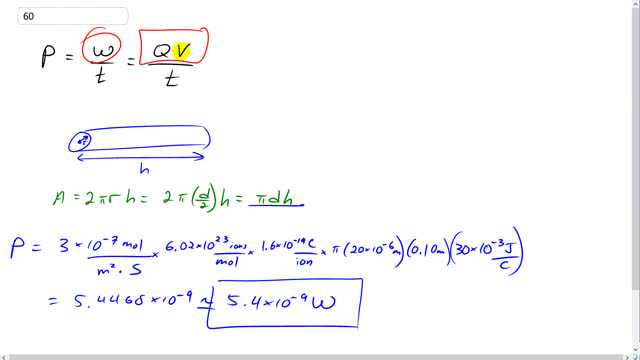
During an action potential, ions move into the cell at a rate of about . How much power must be produced by the “active pumping” system to produce this flow against a +30-mV potential difference? Assume that the axon is 10 cm long and in diameter.

In order to watch this solution you need to have a subscription.
This is Giancoli Answers with Mr. Dychko. Power is work divided by time and the amount of work needed in this case is the CHANGE in potential energy of the ions. As I moved across this potential difference across the membrane and so that's going to be the charge Q TIMES THE POTENTIAL ENERGY PER charge which is what voltages… joules per coulomb. So, the real issue here is some unit conversion we have to figure out how much charge has been moved and, and then per time. And while the time is the easy part because it's one second you know we're told that there's three times then the minus seven moles of sodium ions moved per second for every square meter and… and, and so our unit conversion issue has to do with converting these moles into coulombs and then getting rid of this meter squared which we'll do here and then we'll get rid of the meter squared by multiplying by the surface area of this of this axon. So we'll consider the axon to be a cylinder and the surface area of a cylinder is a circumference of the end multiplied by the length of the cylinder. So that's two pi r times h or two pi times half the diameter times h and then these twos cancel and we have pi d h because we're given the diameter of the of the axon so let's express our area in terms of diameter pi d h and, and that's what I've written here, pi times the diameter of 20 micro-meters which is 20 times ten to the minus six meters times the length which is 0.1 metres, ten centimeters and that area resulting in units of metre squared which cancels with these meters squared here. And then. we have a three time ten to the minus seven moles which means, you know, multiply by Avogadro’s number which is 6.02 times ten to the 23 ions per mole or atoms per mole. But in this case its ions, sodium ions and then multiply by the amount of charge per ion and since this is a sodium ion has a charge of positive one And so that's 1.6 times ten to the minus 19 coulombs per ion and… And then the, And this results in after you're done all this you have coulombs per second and then multiply that by joules per coulomb and the coulombs cancel. And you're left with joules per second which is what Watt is an abbreviation for. So. there we go. So multiply all these numbers together and you get 5.4 times ten to the minus nine watts, is the power required to pump the sodium ions.